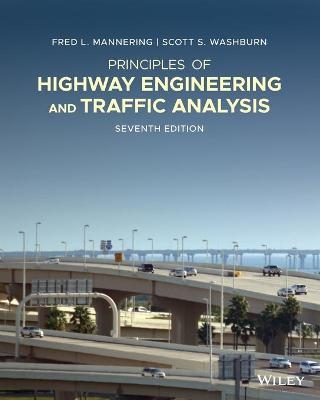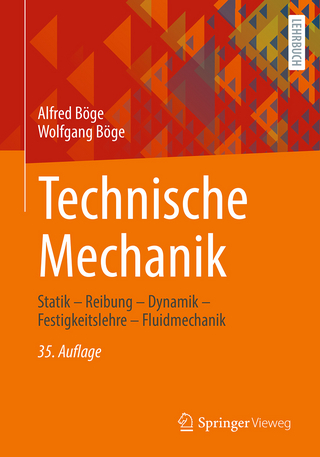
Principles of Highway Engineering and Traffic Analysis
John Wiley & Sons Inc (Verlag)
9781119723196 (ISBN)
This new Seventh Edition features a new e-book format that allows for enhanced pedagogy, with instant access to solutions for selected problems. Coverage focuses exclusively on highway transportation to reflect the dominance of U.S. highway travel and the resulting employment opportunities, while the depth and scope of coverage is designed to prepare students for success on standardized civil engineering exams.
SS Student solution available in interactive e-text
Preface v
Chapter 1 Introduction to Highway Engineering and Traffic Analysis 1
1.1 Introduction 1
1.2 Highways and the Economy 2
1.2.1 The Highway Economy 2
1.2.2 Supply Chains 2
1.2.3 Economic Development 3
1.3 Highways, Energy, the Environment, and Climate Change 3
1.4 Highways as Part of the Transportation System 3
1.5 Highway Transportation and the Human Element 4
1.5.1 Passenger Transportation Modes and Traffic Congestion 4
1.5.2 Highway Safety 5
1.5.3 Demographic Trends 6
1.6 Highways and Evolving Technologies 6
1.6.1 Infrastructure Technologies 6
1.6.2 Traffic Control Technologies 7
1.6.3 Vehicle and Autonomous Vehicle Technologies 8
1.7 Scope of Study 9
Chapter 2 Road Vehicle Performance 11
2.1 Introduction 11
2.2 Tractive Effort and Resistance 11
2.3 Aerodynamic Resistance 12
2.4 Rolling Resistance 15
2.5 Grade Resistance 17
2.6 Available Tractive Effort 18
2.6.1 Maximum Tractive Effort 18
2.6.2 Engine-Generated Tractive Effort 21
2.7 Vehicle Acceleration 25
2.8 Fuel Efficiency 29
2.9 Principles of Braking 30
2.9.1 Braking Forces 30
2.9.2 Braking Force Ratio and Efficiency 32
2.9.3 Antilock Braking Systems 35
2.9.4 Theoretical Stopping Distance 35
2.9.5 Practical Stopping Distance 39
2.9.6 Distance Traveled During Driver Perception/Reaction 42
2.10 Practice Problems 45
Chapter 3 Geometric Design of Highways 53
3.1 Introduction 53
3.2 Principles of Highway Alignment 54
3.3 Vertical Alignment 55
3.3.1 Vertical Curve Fundamentals 57
3.3.2 Stopping Sight Distance 65
3.3.3 Stopping Sight Distance and Crest Vertical Curve Design 66
3.3.4 Stopping Sight Distance and Sag Vertical Curve Design 70
3.3.5 Passing Sight Distance and Crest Vertical Curve Design 78
3.3.6 Underpass Sight Distance and Sag Vertical Curve Design 81
3.4 Horizontal Alignment 84
3.4.1 Vehicle Cornering 84
3.4.2 Horizontal Curve Fundamentals 86
3.4.3 Stopping Sight Distance and Horizontal Curve Design 90
3.5 Combined Vertical and Horizontal Alignment 92
3.6 Practice Problems 98
Chapter 4 Pavement Design 107
4.1 Introduction 107
4.2 Pavement Types 107
4.2.1 Flexible Pavements 108
4.2.2 Rigid Pavements 109
4.3 Pavement System Design: Principles for Flexible Pavements 109
4.4 Traditional AASHTO Flexible-Pavement Design Procedure 110
4.4.1 Serviceability Concept 111
4.4.2 Flexible-Pavement Design Equation 111
4.4.3 Structural Number 118
4.5 Pavement System Design: Principles for Rigid Pavements 122
4.6 Traditional AASHTO Rigid-Pavement Design Procedure 123
4.7 Design-Lane Loads 132
4.8 Measuring Pavement Quality and Performance 137
4.8.1 International Roughness Index 137
4.8.2 Friction Measurements 138
4.8.3 Rut Depth 139
4.8.4 Cracking 139
4.8.5 Faulting 140
4.8.6 Punchouts 140
4.9 Mechanistic-Empirical Pavement Design 140
4.10 Practice Problems 142
Chapter 5 Fundamentals of Traffic Flow and Queuing Theory 151
5.1 Introduction 151
5.2 Traffic Stream Parameters 151
5.2.1 Traffic Flow, Speed, and Density 152
5.3 Basic Traffic Stream Models 157
5.3.1 Speed-Density Model 157
5.3.2 Flow-Density Model 159
5.3.3 Speed-Flow Model 160
5.4 Models of Traffic Flow 162
5.4.1 Poisson Model 162
5.4.2 Limitations of the Poisson Model 166
5.5 Queuing Theory and Traffic Flow Analysis 167
5.5.1 Dimensions of Queuing Models 167
5.5.2 D/D/1 Queuing 168
5.5.3 M/D/1 Queuing 175
5.5.4 M/M/1 Queuing 177
5.5.5 M/M/N Queuing 178
5.6 Traffic Analysis at Highway Bottlenecks 181
5.7 Impact of Autonomous Vehicles 184
5.8 Practice Problems 186
Chapter 6 Highway Capacity and Level-of-Service Analysis 191
6.1 Introduction 191
6.2 Level-of-Service Concept 192
6.3 Level-of-Service Determination 195
6.3.1 Base Conditions and Capacity 195
6.3.2 Determine Free-Flow Speed 195
6.3.3 Determine Analysis Flow Rate 196
6.3.4 Calculate Service Measure(s) and Determine LOS 196
6.4 Basic Freeway Segments 196
6.4.1 Speed versus Flow Rate Relationship 196
6.4.2 Base Conditions and Capacity 198
6.4.3 Service Measure 198
6.4.4 Determine Free-Flow Speed 201
6.4.5 Determine Analysis Flow Rate 202
6.4.6 Calculate Density and Determine LOS 208
6.5 Multilane Highway Segments 211
6.5.1 Speed versus Flow Rate Relationship 212
6.5.2 Base Conditions and Capacity 215
6.5.3 Service Measure 215
6.5.4 Determining Free-Flow Speed 215
6.5.5 Determining Analysis Flow Rate 217
6.5.6 Calculate Density and Determine LOS 217
6.6 Two-Lane Highways 221
6.6.1 Analysis Concepts 222
6.7 Design Traffic Volumes 233
6.8 Practice Problems 237
Chapter 7 Traffic Control and Analysis at Signalized Intersections 243
7.1 Introduction 243
7.2 Intersection and Signal Control Characteristics 244
7.2.1 Actuated Control 247
7.2.2 Signal Controller Operation 250
7.3 Traffic Flow Fundamentals for Signalized Intersections 253
7.4 Development of a Traffic Signal Phasing and Timing Plan 256
7.4.1 Select Signal Phasing 257
7.4.2 Establish Analysis Lane Groups 261
7.4.3 Calculate Analysis Flow Rates and Adjusted Saturation Flow Rates 263
7.4.4 Determine Critical Lane Groups and Total Cycle Lost Time 263
7.4.5 Calculate Cycle Length 266
7.4.6 Allocate Green Time 268
7.4.7 Calculate Change and Clearance Intervals 270
7.4.8 Check Pedestrian Crossing Time 272
7.5 Analysis of Traffic at Signalized Intersections 273
7.5.1 Signalized Intersection Analysis with D/D/1 Queuing 274
7.5.2 Signal Coordination 281
7.5.3 Control Delay Calculation for Level of Service Analysis 289
7.5.4 Level-of-Service Determination 294
7.6 Practice Problems 299
Chapter 8 Travel Demand and Traffic Forecasting 311
8.1 Introduction 311
8.2 Traveler Decisions 313
8.3 Scope of the Travel Demand and Traffic Forecasting Problem 313
8.4 Trip Generation 316
8.4.1 Typical Trip Generation Models 317
8.4.2 Trip Generation with Count Data Models 320
8.5 Mode and Destination Choice 322
8.5.1 Methodological Approach 322
8.5.2 Logit Model Applications 324
8.6 Highway Route Choice 329
8.6.1 Highway Performance Functions 330
8.6.2 User Equilibrium 331
8.6.3 Mathematical Programming Approach to User Equilibrium 336
8.6.4 System Optimization 337
8.7 Autonomous Vehicles, Highway Performance Functions, and System Optimization 341
8.8 Traffic Forecasting in Practice 342
8.9 The Traditional Four-Step Process 346
8.10 The Current State of Travel Demand and Traffic Forecasting 347
8.11 Practice Problems 348
Appendix 8A Least Squares Estimation 352
Appendix 8B Maximum-Likelihood Estimation 354
Problems P-1
Index I-1
| Erscheinungsdatum | 06.08.2020 |
|---|---|
| Verlagsort | New York |
| Sprache | englisch |
| Maße | 201 x 252 mm |
| Gewicht | 726 g |
| Themenwelt | Technik ► Bauwesen |
| ISBN-13 | 9781119723196 / 9781119723196 |
| Zustand | Neuware |
| Informationen gemäß Produktsicherheitsverordnung (GPSR) | |
| Haben Sie eine Frage zum Produkt? |
aus dem Bereich


